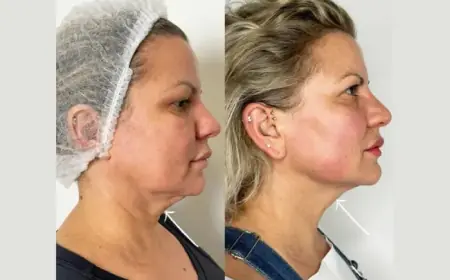Navigating Second Chances: Finding the Right Plastic Surgeon for Revision Surgery
Patients seeking the Best Plastic Surgeon in Riyadh, Jeddah and Saudi Arabia for a corrective procedure understand that this field requires a distinct set of skills and a deeper level of experience than initial surgeries.

The pursuit of aesthetic enhancement is often a deeply personal journey aimed at boosting confidence and achieving a desired appearance. For many, initial plastic surgery procedures deliver satisfying results, aligning perfectly with their expectations. However, the human body is dynamic; it heals in unique ways, undergoes changes due to aging or weight fluctuations, and sometimes, the initial outcome may not fully meet the patient's vision or functional needs. In such cases, the option of revision surgery emerges – a specialized path to refine, correct, or improve upon previous surgical results, emphasizing that aesthetic transformation can be an ongoing process rather than a single event.
The Specialized Need for Revision Surgeons in Saudi Arabia
Saudi Arabia's aesthetic medicine sector has flourished, with cities like Riyadh and Jeddah offering a wide array of advanced plastic surgery procedures. As the volume of primary surgeries increases, so does the nuanced demand for expert revision surgery. Patients seeking the Best Plastic Surgeon in Riyadh, Jeddah and Saudi Arabia (أفضل جراح تجميل في الرياض) for a corrective procedure understand that this field requires a distinct set of skills and a deeper level of experience than initial surgeries. A revision surgeon navigates altered anatomy, scar tissue, and often, heightened patient expectations, making their specialized expertise invaluable. The focus in the Kingdom's leading clinics is increasingly on providing these complex, refined solutions to ensure patient satisfaction and optimal long-term results.
What is Revision Plastic Surgery?
Revision plastic surgery refers to a secondary surgical procedure performed to improve or correct the outcome of a previous cosmetic or reconstructive operation. It's a highly specialized area within plastic surgery, often more complex than the initial procedure because the surgeon must work with altered tissues, existing scar tissue, and potentially compromised anatomy.
-
Corrective Nature: The primary goal is to address unsatisfactory results from a prior surgery, whether they are aesthetic (e.g., asymmetry, unnatural appearance, residual deformities) or functional (e.g., breathing difficulties after rhinoplasty).
-
Increased Complexity: Revision surgeries are inherently more challenging. The surgeon needs to understand how the previous surgery affected the tissues and plan meticulously to re-establish normal anatomy or achieve a more harmonious aesthetic.
-
Patient Dissatisfaction: Often, patients seek revision surgery due to dissatisfaction with the initial outcome, which might stem from unmet expectations, minor irregularities, or significant complications.
-
Natural Changes: Sometimes, revision is needed due to natural aging, weight fluctuations, or other life changes that have altered the results of the initial surgery over time.
This type of surgery demands a unique blend of technical skill, artistic judgment, and a deep understanding of tissue healing.
Why Patients Seek Revision Surgery
There are various reasons why individuals might pursue revision plastic surgery, reflecting a range of outcomes from their initial procedures.
-
Unsatisfactory Aesthetic Outcome: This is a common reason, where the patient is unhappy with the shape, size, symmetry, or overall appearance of the treated area, finding it doesn't align with their initial vision. Examples include an unnatural-looking facelift, asymmetrical breasts, or an unbalanced nose shape.
-
Complications from Previous Surgery: Despite the best efforts, complications can sometimes arise from the initial surgery. These might include noticeable scarring (e.g., hypertrophic or keloid scars), capsular contracture (hardening around breast implants), implant displacement, or seroma/hematoma formation.
-
Functional Problems: In some cases, a primary cosmetic procedure can lead to functional issues. For instance, rhinoplasty might result in breathing difficulties, or eyelid surgery could impact eye closure. Revision surgery aims to restore proper function.
-
Unrealistic Initial Expectations: Sometimes, the initial outcome was technically sound, but the patient's expectations were not fully aligned with what was achievable. A revision surgeon can help redefine realistic goals.
-
Changes Over Time: The body continues to age and change. Weight fluctuations, gravity, and the natural aging process can alter the results of even well-performed initial surgeries, necessitating a revision to maintain or restore the desired aesthetic.
Understanding these underlying reasons is crucial for both the patient and the revision surgeon in planning the most effective corrective approach.
The Unique Challenges of Revision Surgery
Revision plastic surgery presents distinct challenges that differentiate it significantly from primary procedures. These complexities underscore the need for a highly specialized surgeon.
-
Altered Anatomy: The most significant challenge is working with tissues that have already undergone surgical alteration. Scar tissue is often present, which can be less pliable, have compromised blood supply, and react differently to further manipulation.
-
Scar Tissue Management: Existing scar tissue can make dissection more difficult, increase the risk of bleeding, and influence the final outcome. The revision surgeon must be expert in managing and minimizing new scarring.
-
Compromised Tissue Quality: Previous surgery can sometimes affect the blood supply or overall health of the tissues, making them more delicate and prone to complications during a revision.
-
Unpredictable Healing: The body's healing response to a second or third surgery can be less predictable than to a primary procedure, requiring greater surgical finesse and careful post-operative management.
-
Increased Risk of Complications: While still generally safe, revision surgeries carry a slightly higher risk of complications such as infection, bleeding, or prolonged swelling due to the already manipulated tissues.
-
Higher Patient Expectations: Patients seeking revision often have heightened emotional investment and expectations, which the surgeon must manage with empathy and clear communication about achievable results.
These inherent difficulties necessitate a surgeon with exceptional skill, experience, and judgment.
Key Qualities of the Best Plastic Surgeon for Revision Surgery
Finding the ideal plastic surgeon for a revision procedure requires looking beyond standard qualifications and focusing on specific attributes that signify expertise in this complex area.
-
Deep Anatomical Knowledge: An exceptional revision surgeon possesses an exhaustive understanding of anatomy, not just in its pristine state, but how it is altered by various surgical procedures and scar formation.
-
Extensive Experience in Revision Cases: While general plastic surgery experience is important, look for a surgeon who has a significant track record specifically in revision surgeries, particularly for the type of procedure you need. Their portfolio should reflect this specialization.
-
Problem-Solving Acumen: Revision surgery often involves diagnosing and correcting issues from a previous operation. The best revision surgeons are adept at critical thinking and developing creative solutions for unique and challenging problems.
-
Meticulous Surgical Technique: Precision and meticulousness are paramount. The surgeon must be able to work delicately with compromised tissues, minimizing further trauma and optimizing conditions for healing and graft survival.
-
Realistic and Ethical Communication: A top revision surgeon will provide an honest assessment of what can be achieved, outlining potential limitations and managing expectations realistically. They will never promise perfection but strive for significant improvement.
-
Patience and Perseverance: Revision cases can sometimes be multi-staged, requiring patience from both the surgeon and the patient. The best surgeons are committed to the long-term journey of achieving the desired outcome.
-
Aesthetic Judgment: An unparalleled artistic eye is crucial for revision surgery, as the goal is to bring harmony and balance to an area that may have been aesthetically disrupted.
These qualities, combined with standard credentials, define a truly outstanding revision plastic surgeon.
The Consultation Process for Revision Surgery
The initial consultation for revision surgery is even more critical than for a primary procedure. It's an opportunity for a thorough assessment and candid discussion.
-
Comprehensive Review of Medical History: The surgeon will need detailed information about your previous surgery, including operative reports if available, and any complications you experienced.
-
Detailed Physical Examination: A meticulous examination of the affected area will be performed to assess the quality of existing tissues, the extent of scarring, and the underlying anatomical issues.
-
Discussion of Concerns and Goals: You'll have ample time to express your dissatisfaction with the previous results and articulate your specific goals for the revision. Be prepared to show photos of what you ideally envision.
-
Feasibility and Realistic Expectations: The surgeon will discuss the feasibility of achieving your goals given the existing anatomy and scar tissue. They will set realistic expectations, explaining what is achievable and what might not be possible.
-
Customized Treatment Plan: A personalized surgical plan will be developed, outlining the proposed techniques, estimated recovery, and potential need for staged procedures.
-
Review of Risks: The unique risks associated with revision surgery will be thoroughly explained.
-
Review of Before & After Photos: The surgeon should share examples of their own revision cases to demonstrate their skill and the types of results they achieve in complex scenarios.
This in-depth consultation ensures both you and the surgeon are aligned on the path forward.
Recovery from Revision Plastic Surgery
Recovery from revision plastic surgery can often be more prolonged and variable than from a primary procedure, largely due to the challenges presented by previously operated tissues.
-
Increased Swelling and Bruising: Due to the manipulation of already traumatized tissues, swelling and bruising might be more significant and last longer compared to initial surgery.
-
Longer Healing Time: The body's healing response in areas with scar tissue can be slower. It's crucial to allow ample time for the tissues to settle and for the full results to emerge.
-
Scar Management: Post-operative scar management will be a key focus, often involving massage, silicone sheeting, or other therapies to optimize scar appearance.
-
Close Monitoring: Your surgeon will likely schedule more frequent follow-up appointments to closely monitor your healing progress and address any concerns promptly.
-
Patience is Key: It's vital to exercise patience throughout the recovery period. Final results may take 12-18 months, or even longer for some complex revisions, to fully materialize.
-
Adherence to Instructions: Strict adherence to your surgeon's post-operative instructions regarding activity restrictions, wound care, and medication is absolutely critical for a successful outcome.
Understanding the unique aspects of revision recovery helps set realistic expectations and promotes a smoother healing process.
The Importance of the "Best Plastic Surgeon in Riyadh, Jeddah and Saudi Arabia" for Revision
The decision to undergo revision plastic surgery is often made with a higher level of anxiety and hope. This is why choosing the Best Plastic Surgeon in Riyadh, Jeddah and Saudi Arabia becomes even more paramount for these complex cases. Leading surgeons in the region:
-
Possess Unrivaled Expertise: They have a profound understanding of intricate anatomy and the complexities introduced by previous surgeries.
-
Demonstrate Surgical Artistry: Their ability to sculpt and refine already altered tissues to achieve a harmonious and natural outcome is exceptional.
-
Prioritize Patient Safety: They operate in fully accredited facilities with robust safety protocols, ensuring the highest standards of care.
-
Offer Compassionate Support: They understand the emotional toll that unsatisfactory previous results can take and provide empathetic guidance throughout the revision journey.
-
Are Leaders in Innovation: They stay current with the latest advancements in revision techniques, offering cutting-edge solutions.
For those seeking to correct or refine previous aesthetic work, entrusting their care to a top-tier revision plastic surgeon is the pathway to achieving their ultimate aesthetic goals.
The Future of Revision Surgery: Precision and Personalization
The field of revision plastic surgery is continuously advancing, driven by innovations in imaging, surgical instrumentation, and understanding of tissue healing. Future developments promise even greater precision, potentially leveraging 3D modeling and AI-assisted planning to anticipate challenges and optimize outcomes. The emphasis will remain on personalized treatment plans, recognizing that each revision case is unique. As the global standard for aesthetic excellence rises, so too will the specialized capabilities of the best plastic surgeons in Riyadh and across Saudi Arabia, ensuring that individuals have access to the most sophisticated and compassionate care for their aesthetic refinements.
Frequently Asked Questions
What makes revision plastic surgery more challenging than an initial procedure?
Revision plastic surgery is generally more challenging than an initial procedure primarily because the surgeon must work with altered anatomy and existing scar tissue. Tissues that have already undergone surgery may have compromised blood supply, be less pliable, and react differently to further manipulation. Scarring can obscure normal anatomical planes, making dissection more difficult and increasing the risk of complications. This complexity requires a higher level of surgical skill, precision, and an in-depth understanding of how previous procedures have affected the area.
How long should I typically wait between my primary plastic surgery and considering a revision?
It is generally recommended to wait at least 6 to 12 months (and often longer for certain procedures like rhinoplasty, sometimes up to 18 months or more) between your primary plastic surgery and considering a revision. This crucial waiting period allows for complete healing, resolution of swelling, and the full maturation of your initial results. Assessing the final outcome of the first surgery accurately is essential before planning any corrective procedures, as many minor irregularities or concerns can resolve naturally over time without further intervention.
Are the results of revision plastic surgery as predictable as primary procedures?
The results of revision plastic surgery can be less predictable than primary procedures due to the inherent complexities involved. Working with scar tissue and previously altered anatomy introduces variables that are not present in an initial surgery. While a highly skilled and experienced revision surgeon can achieve significant improvements and very satisfying outcomes, they will always provide realistic expectations. The degree of improvement achievable depends heavily on the initial problem, the quality of existing tissues, and the patient's individual healing capacity.
What's the most critical factor when choosing a plastic surgeon for a revision procedure?
The most critical factor when choosing a plastic surgeon for a revision procedure is their demonstrated expertise and extensive experience specifically in revision surgery for your particular concern. While general board certification is a must, a surgeon who routinely performs complex revision cases, understands the unique challenges of working with previously operated tissues, and has a strong portfolio of successful revision outcomes is paramount. Their ability to assess altered anatomy, manage scar tissue, and approach the problem with a nuanced, problem-solving mindset is key to achieving the best possible corrective result.
For further information and to explore your options, you can visit
What's Your Reaction?
 Like
0
Like
0
 Dislike
0
Dislike
0
 Love
0
Love
0
 Funny
0
Funny
0
 Angry
0
Angry
0
 Sad
0
Sad
0
 Wow
0
Wow
0


















































